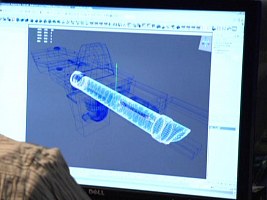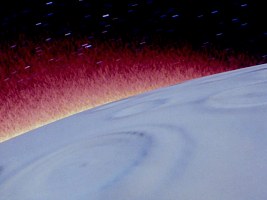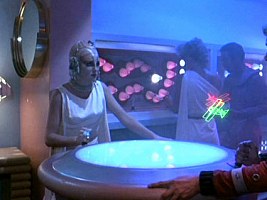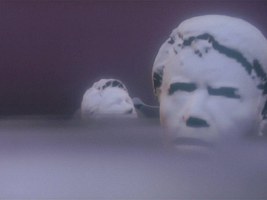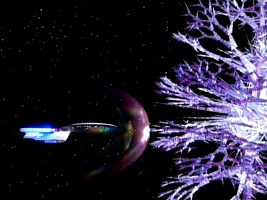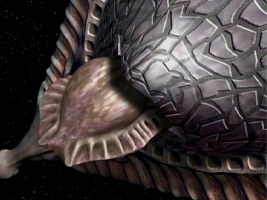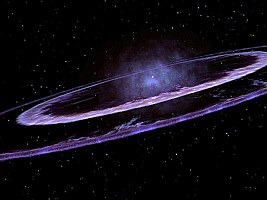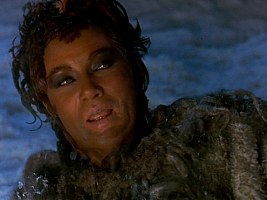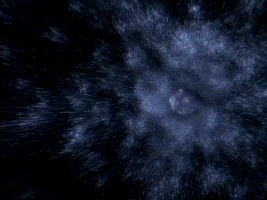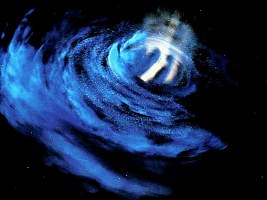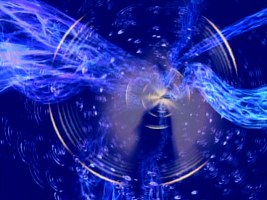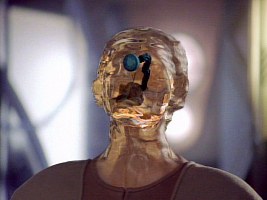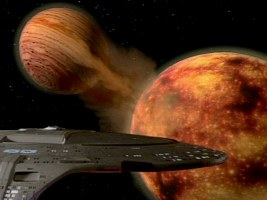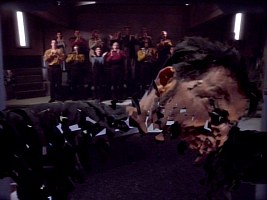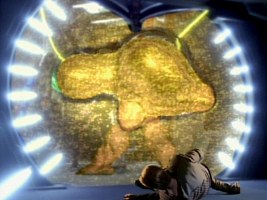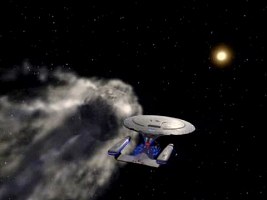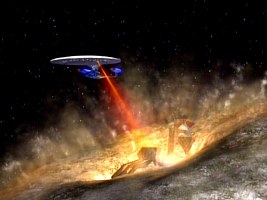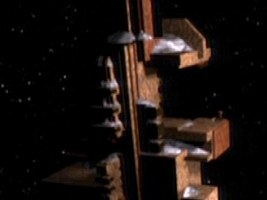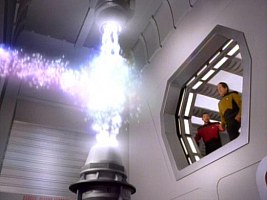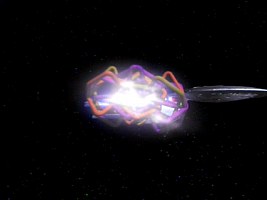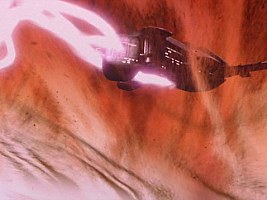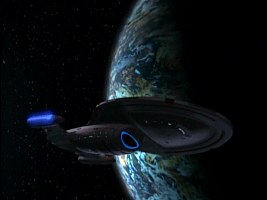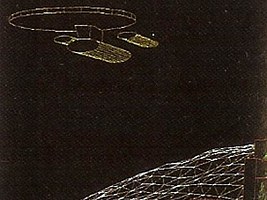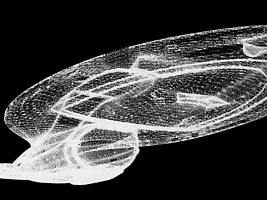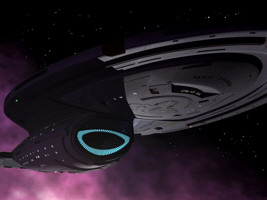CGI in Star Trek
Originally created by Sennim et al. for Memory Alpha
Use of CGIComputer SoftwareComputer HardwareBuilding a CGI ModelDurability of CGI Models
CGI Suppliers to Star TrekCGI Starships and StructuresCGI Species
 For post-Enterprise developments, please refer to the current version of this article at Memory Alpha.
For post-Enterprise developments, please refer to the current version of this article at Memory Alpha.
Use of CGI
The very first CGI created for Star Trek, was in "Star Trek II: The Wrath of Khan", where the Graphics Group of Lucasfilm was responsible for the Genesis effect as a subcontractor of the movie's effects company, Industrial Light & Magic (ILM). The Graphics Group would later evolve to Pixar.
Very limited CGI was used in the next four Star Trek films and Star Trek: The Next Generation due to the expense of creating CGI images at the time, though producers Robert Justman and Edward K. Milkis investigated the feasibility of applying CGI to the new television show. "Eddie Milkis and I investigated the possibility of generating everything on the computer. We had great reservations about it, because it still didn't have the reality. The surface treatment wasn't totally believable [remark: Justman is referring to a CGI refit-Constitution-class that was commissioned for evaluation]; we could have gotten by, it would have been acceptable, but it wasn't satisfactory." as Justman recalled. (Star Trek: The Next Generation USS Enterprise NCC-1701-D Blueprints, accompanying booklet, page 14 and Cinefex, no.37, page 10) Milkis further elaborated, "It was incredibly good, and it took some real thinking on our part, but ultimately we decided that if something ever happened to that company and they couldn't deliver, then we'd have nothing. We were very concerned about that and ultimately they did go out of business."(Star Trek: The Next Generation Companion, page 11)
Of the Star Trek production team, David Stipes and, at a later time to a lesser degree, Mitch Suskin, Dan Curry and Ronald B. Moore were the foremost advocates of applying CGI, Stipes already overseeing some of its earliest applications, during the sixth season of TNG. Stipes already lobbied in vain for a CGI version of the USS Enterprise-D during that season, "On 'The Chase' we were all over the galaxy -warp here and warp there- and I have basically the one or two jumps to warp that we had in stock. When TNG was started, the first bits of material were shot at ILM and they shot the original jump to warp with slit scan and streak photography. That served us very well for seven years, but it was very difficult to do and expensive. I had been pushing to build a CGI Enterprise, but no one wanted to incur the expense at that point so I lived with the stock shots." (Cinefantastique, Vol. 27, No. 4/5, page 79) Aside from the perceived cost issue, there was also the barrier of reluctance of accepting the new technology by producers and makers of SFX, born and bred in the true and tried traditional methods of producing SFX. Essentially speaking for all of them, DS9's visual effects producer Robert Legato put it very succinctly, "It looks too pristine. I don't believe it." (Cinefantastique, Vol. 24, No. 3/4, page 105)
A December 1993 Christmas party thrown by NewTek (the company that owns and markets the LightWave 3D software) provided a key moment for overcoming the Trek producers' resistance to CGI, when Stipes met the animators of Amblin Imaging. Amblin's John Gross recalled, "David was always interested in getting 3-D incorporated into Star Trek. He saw the benefits of that probably before many of the other producers over there did. And so we invited him over here and showed him the facility and when Voyager came up he saw the opportunity to get this stuff involved. He and Dan Curry came by and we talked about what we can do and showed them some examples and eventually we gave them a bid to build a virtual Voyager." To prove their skills Gross and Grant Bouchet took some stock footage of a Maquis raider with the accompanying motion control data, provided by the studio, and added some CGI ships. Matching flight movements so perfectly, DS9 producers were not able to distinguish between the physical models and CGI models. Vice-president John Parenteau related further, "That meant a lot to Dan Curry, because Dan was weary. I think he had some bad experiences with CGI in the past and didn't feel it was quite there yet. But when we turned out their flight tests and people couldn't tell the difference, Dan started to realize that maybe we have finally conquered whatever barrier there had been before." (Cinefantastique, Vol. 27, No. 4/5, page 80)
The following gallery shows some notable examples of early CGI in Star Trek.
The cost of CGI production dropped dramatically after LightWave 3D became commercially available off the shelf in 1994. Star Trek: Deep Space Nine and Star Trek: Voyager had both implemented CGI in their title sequences (created in 1992 and 1994, respectively). Both series began their runs predominantly using traditional special effects methods, but transitioned to regular use of CGI in the late 1990s. The transition to CGI was completed in 1997, during DS9's sixth season and Voyager's fourth season; Voyager took the lead, having been unofficially designated as a testbed for the technology, and DS9 followed suit. Deep Space Nine was particularly well served by CGI in its last two seasons, allowing the series to showcase Dominion War battle scenes that would have been impossible using models.
Star Trek: Enterprise was exclusively done in CGI for almost all exterior ship shots, as were the movies from "Star Trek: Insurrection" onwards. Cost-effectiveness by that time had reached a level that made CBS Studios take the decision in 2005 to retro-apply CGI to Star Trek: The Original Series for virtually all its exterior SFX shots, resulting in the 2006 remastered version of TOS with revised ships, planet models and planet surfaces.
For the movies it was "Star Trek Generations" that marked the true breakthrough of CGI. Up until then CGI in motion pictures was employed in isolated instances on a limited scale, but in "Generations" CGI was used throughout the movie as an integral part for a wider variety of effects. Still, the amount of work in creating them was such that to ease their workload ILM solicited the help of other effects houses such as Digital Magic and Santa Barbara Studios. By the time "Star Trek: Insurrection" was in pre-production, it was decided that the SFX for the entirety of the production would be created in CGI. However, in a last-minute decision the film's SFX supervisors decided to create the scene with the destruction of the Son'a collector in motion control photography with physical studio models, because they believed that the scene could not yet be done convincingly in CGI. (Sci-Fi Fantasy Models, 1999, No's 34-35) Similarly, in "Star Trek Nemesis" the scene in which the USS Enterprise-E rams the Scimitar was achieved with physical models and motion control. (Cinefex, No.93, pages 107-109)
The perceived cheapness of CGI has been put more in perspective by Adam "Mojo" Lebowitz, at the time modeler and effects supervisor at Foundation Imaging: "I think the cost-effectiveness of it came slowly into play. A lot of people say, 'CGI is a lot cheaper, isn't it,' but the way I like to think of it is that CGI is not cheaper necessarily, but you get a lot more for your money and you can tweak it a lot more. They [the producers] like that, because with motion control if they had a complex shot that had a small problem it would be very, very expensive to go back and reshoot all the elements. But in fact I don't like to use the word 'cheaper'; CGI is more versatile, far more cost-effective." (Star Trek: The Magazine, Volume 1, Issue 6, page 47)
The versatility Lebowitz refers to, comes into play especially once the CGI model is finished and loaded onto a server. For example, an explosion which was originally done by pyrotechnics; stock footage of which was shot and later inserted in post-production in whatever production it was deemed necessary, a technique often used with the films and TNG. The only options open to editors of those days were, size, placement and intensity. In CGI, once an explosion has been modeled, the original file can be manipulated, with embedded or not software, to change intensity, color, direction, size, movement or in short changed completely beyond recognition and be inserted anywhere in a frame a producer likes, since nowadays productions are edited digitally, quite literally by a click of a mouse-button. This versatility has been proven exceptionally useful for the producers of Star Trek in kitbashing CGI studio models. Whenever a new design was called for in a script and, due to time or budgetary restraints, a new design was not feasible, existing CGI models of starships were used as they were easily adaptable into another type of ship, a method frequently employed during VOY and ENT, such as with the various modifications of the Akritirian patrol ship. Using CGI also meant that pre-production evaluation shots of SFX by special effects supervisors, could be done on a computer screen instead of having it played out in real-time, thereby in the process eliminating the use of camera test models.
Computer Software
CGI made its tentative entry into the motion picture industry in the 1970's in movies like "Futureworld", "Star Wars", "Alien", "The Black Hole" and "Star Trek II: The Wrath of Khan". In most cases the CGI were limited 3D- wire-frame models, aptly used as computer displays. The Genesis effect sequence, created by ILM on their own in-house developed software for "The Wrath of Khan", was not only a CGI first for Star Trek, but was also the very first fully CGI realized 3D-sequence, not being a wire-frame but rather a full textured 3D-representation, ever to be shown in the motion picture business. CGI was generated using computer programs, developed at universities or by in-house programmers of SFX companies, meaning that interchangeability was non-existent. The first solid 3D CGI models were featured in the movies "Tron" and "The Last Starfighter". Though, in the first case, critically acclaimed, the movies were considered commercial failures and convinced directors and producers of the time that CGI could only be used in instances where effects were supposed to look like computer-images.
Things changed dramatically in 1993 when the movie "Jurassic Park" was released and the TV series Babylon 5 premiered. Modelers at ILM and Foundation Imaging used the in 1990 commercially released first version of the LightWave 3D software package (then called "Video Toaster Suite", a hardware/software combination; the software was from 1994 onward available as a stand-alone application) to create life-like convincing 3D CG imagery. The success of both productions meant the definitive breakthrough of CGI in the motion picture business and LightWave and its successive versions has become the premiere software package for its creation. The list of productions having used LightWave since 1993 is impressive and within a decade, traditional methods of producing SFX were relegated to the fringes. All companies that provided CGI for later seasons of DS9, VOY and the entirety of ENT used a version of LightWave, greatly improving production efficiency since computer files were easily interchangeable between the companies' platforms (The co-operation between Foundation Imaging and Digital Muse for the production of DS9: "Sacrifice of Angels" is a prime example).
Interchangeability of CGI-files created on different software platforms, is often possible, but it almost always means a fair amount of reprogramming and reconstructing as Digital Muse experienced when ILM turned over their ship models, made for "Star Trek: First Contact" for use in DS9. For some companies it is then more expedient to newly construct a CGI model from the ground up. "ILM actually released their Enterprise database to us, which was very nice of them. It was very helpful in the beginning, because we had all these animatics to create. However, their Enterprise was a fairly low-resolution model, and while we originally thought, 'Maybe we can just add to this database', that process became more trouble than it was worth, so we had Viewpoint Datalabs come down and actually redigitize the Enterprise using the original miniature.", Santa Barbara Studio's effects supervisor John Grower said in preparation of "Star Trek: Insurrection". (American Cinematographer, January 1999, page 41) Appearing in three movies, for which four different CGI companies provided the SFX, each using different software, the CGI version of the Sovereign class was built from scratch no less than four times. Michael Stetson who had to rebuild the Jem'Hadar fighter in LightWave from the VisionArt files for DS9: "Sacrifice of Angels" gave another example, "I don't remember where exactly the original model came from, but I believe we got it as a .obj file that was a mess when it was imported into Lightwave (version 5.5ish back in '97) I had a couple of days to make it usable in Lightwave3D which involved seriously cleaning up the geometry (I think the original might have been NURBS) and redoing the texture map since LW didn't have UV mapping back then." (Drex Files)
However, as supervisor Bruce Branit of Digital Muse explained, referring to DS9: "Sacrifice of Angels", sometimes the effort of transferring CG-files to another software format was worthwhile:
"It was the first time that anyone had actually assembled the entire Starfleet fleet in CG. Normally there were always a few ships they used for CG, and they pulled models out, and did motion control. Due to the nature of the show, there was no way they could do it with motion control. There was not enough time and not enough money. They were talking about having fifty to a hundred Starfleet vessels on screen at one time, and there was no way to pull that off in traditional ways. So we were a collecting point for anything that had been done in CG before. We brought the digital models in and converted them to LightWave, which is our rendering package of choice. The Enterprise-D had been done before, but in something else, so we were able to bring the geometry in, and bring some of the maps in, but we had to rebuild it. We had all the ingredients, so we could put it together much more quickly than building it from scratch. So now we have folders with the entire fleet all lined up in the same form, so we can just load a Reliant, we can load a Defiant, we can load an Excelsior, whenever we need it. That was the first real challenge, to get all that stuff in order, and to fill the garage with useable ships." (Cinefantastique, Vol.30, No.9/10, page 64)
Tackling the ILM models, done for "Star Trek Generations" and "Star Trek: First Contact", in an early stage, Digital Muse was able to showcase the upgraded versions already in DS9: "Call to Arms".
Even interchangeability of CGI-files generated on the same software platforms was sometimes not without its problems as John Gross remembered in respect to transferring the CGI version of the USS Voyager from one version of LightWave to another:
"There are six shots in the opening title sequence, three of them had the CG ship that we built; the other three have the practical model. The three that had the CG ship were the one where it goes by the sun, the one where it goes through the smoky, particle stuff, and the last one, where it jumps to warp. (...) We always use beta software [remark: meant is a new version of Lightwave which at the time was available on two different computer systems, Amiga being the hardware component of the 1990 'Video Toaster Suite' package], which means there tend to be some bugs. As we were modeling Voyager, some of it was being done in the Amiga version; some was being done on the SGI version. If you transferred the model between the different systems, the textures-effectively the paint on the ship-would get lost. That happens in the final shot where the belly tips up toward us and Voyager goes to warp. It's something you don't really pick out unless you know it's there, but if you look at the bottom of the ship there are these three darker patches that aren't supposed to be there - it's where there are some ports and hull plating. That made it into the title sequence. Nobody said anything, and we never mentioned it!" (Star Trek: The Magazine, Volume 3, Issue 3, page 112)
Adam Lebowitz, no doubt speaking from experience, estimates that it will take six to twelve months of study in one's spare time to master the LightWave software. (Star Trek: The Magazine, Volume 1, Issue 6, page 51) As a consequence designers and modelers like Doug Drexler, John Knoll and Larry Tan made the transition from the traditional way of producing SFX to CGI.
Though LightWave is a prime software package for generating CGI, it is by no means the only software available; in fact the majority of Star Trek films does not sport CGI generated by LightWave. ILM uses a myriad of software, often in conjuncture with each other, both developed in-house and off-the-shelf and has not used LightWave for Star Trek since "Star Trek VI: The Undiscovered Country". Santa Barbara Studios used in-house developed software (Dynamation) in conjuncture with off-the-shelf software (WaveFront, ViewPoint, Maya) to create the spatial phenomena in the title sequence of VOY and the SFX in "Star Trek: Insurrection", whereas VisionArt had a package called "Side Effects' Prism" (which may explain why their services were no longer called upon after DS9's fifth season, when the studio continued with the LightWave using Digital Muse and Foundation, at least for televised Star Trek). Of the later films, only the CGI in "Star Trek Nemesis" was done in LightWave.
Computer Hardware
CGI companies require a lower capital lay-out than full-fledged production companies as Lebowitz elaborates:
"At Foundation, most of our workstations are regular off-the-shelf PC's [prices of which dropped sharply in the 1990's] -the same as anyone reading the magazine probably has. Fast Pentiums with lots of RAM (256 megs or more) is about average. We don't need a lot of hard disc space, since all the frames get stored on a massive server. The render engines, which create all the animation frames, are a mix of Pentium computers and DEC Alphas (a faster PC). Other equipment includes videocards with Open GL, a mode that lets you preview LightWave scenes in a sort 'rough draft' mode in real time. All our machines also sport 'Perception' cards from DPS, which allow us to compile the final frames into full screen video playback. We also have a soda machine with a built-in icemaker!" (Star Trek: The Magazine, Volume 1, Issue 6, page 47)
The relatively low capital lay-out (essentially only office space and computers), however was also partly responsible for the high turnover in number of CGI companies, especially in the early days. As easy as it was to startup a company, it was also as easy to close down companies in situations as slow business (Amblin, Foundation) or hostile take-overs (Digital Muse). In case of bankruptcy a specific problem arises as Lebowitz showed in response to the question if Star Trek: Voyager could be transferred to High Definition,"When Foundation closed down, the servers — along with the content — were auctioned off. Much of the content may have been saved by artists who worked on the series, but it would have to be tracked down. No matter how you slice it, it would be a considerable amount of work to re-integrate the entire Voyager visual effects server and re-render the FX in HD. In addition, although the series was shot on film, the entire post-production process was finished on NTSC video; to create an HD episode of Voyager, Paramount would have to go back to the vaults, re-transfer the film and re-built the episodes from scratch using the original editing data — if THOSE files still existed." (dartmojo.wordpress.com) In a similar earlier case with Digital Muse, Paramount, had the good sense to retain ownership of the contents and the whole contents of Digital Muse's server was transferred one-on-one to the servers of its successor Eden FX.
Building a CGI Model
John Gross of Digital Muse breaks down the procedure of building a CGI model:
"If we get a design from the Trek Art Department, we might get just a 3/4 perspective drawing, or we may get all sides. It really depends on whether the ship is a 'hero' (one that will be seen a lot and close up) model or not. At that point, the artist assigned to modeling it will start breaking it down into its basic shapes and start creating it in the computer. Sometimes they'll start with a shape that is close (like a box) and start adding geometry and reshaping it to fit. Sometimes, they will have to create it polygon by polygon. Once the geometry is created, then it has to be surfaced to look real. This is where we'll add weathering, decals and the like to make it look like a real vessel. For almost all of the ships we built for DS9, there was an existing practical model to begin with. In the beginning of Voyager, there were existing models, but by the end, everything was CG. For the new series, Enterprise, everything will be CG. If a practical model does exist, that model will generally get delivered to us so we can have the real thing there to base the CG version upon. This was a lot of fun for DS9, because a lot of real models came through our shop. Things like the Reliant and Enterprise-A from Wrath of Khan, the Defiant, the Excelsior, Ferengi ships and Cardassians, At one point, I think we had about 8 models in house as we were building the CG fleet for DS9." (LCARScom.net)
Building
A CGI effect conceived as a 3D solid object, whether it was a starship, structure or a celestial object, normally started out life as a wire-frame model or 3D Mesh as it is also referred to. As the name already suggests it is a simplified computer model defining the contours of the model in question. The more refined the wire-frame was (meaning the more contour lines the computer model has), the more refined the final CG-model was to become. In case of existing studio models, some companies like Santa Barbara Studios, Amblin Imaging and Digital Domain hired specialized companies like Viewpoint Data Labs or Cyberscan, who digitally scanned the physical models to construct a wire-frame CG model (a process sometimes referred to as digitizing), whether or not clad with a non-descript smooth skin generated for example as NURBS. Final application of skin, called mapping and animation were done at the effects houses themselves, using photographs taken from the actual physical studio models loaded into the computer programs. The CG-models, for example, of the Galaxy-class, Intrepid-class and Sovereign-class were thus conceived.
In the case of new models the meshes were created in the respective software modules freehand from either the design drawings or the actual physical studio models themselves. Gross's statement about the 3/4 perspective drawings is reminiscent of a remark John Eaves made, "Most of the time with models all you need is a three-quarter view, and a couple of three-quarter angles on different parts of the ship." (Star Trek: The Magazine, Volume 1, Issue 2, page 22) Speaking for televised Star Trek, three-quarter views were preferred by some CG-modelers since they could load those drawings directly into their computers and build the meshes directly onto them, they already conveying a sense of 3-dimensionality, in essence cutting corners.
Rendering and animation
Once a model was built, the finished model was loaded into dedicated software, embedded into modules of a larger software package or not, for mapping, lighting and animation (imbuing the CG model with movement), a process referred to as rendering and animation (if the software was part of a larger software package: loaded into a rendering engine). The term "rendering" is often incorrectly used to describe the whole creation process of a CGI-effect whereas it is only meant to describe the mapping and lighting stage, animation being a separate stage.
Other
While many CGI effects started out as solid 3D-objects, constructed at first as wire-frame meshes, not all CGI effects originated as such. Effects like water, clouds, rain, fire, dust, vapor, hair and such could not be realized by building wire-frame models, but were rather created by using particle generator programs. A pioneer program for creating these kind of effects was Santa Barbara Studios' Dynamation software program, later embedded as a module in the Maya software package, an alternative to LightWave 3D. It was this software that created much of the title sequence of Star Trek: Voyager. Such was its importance that Dynamation earned developer Jim Hourihan an "Academy Award for Technical Achievement" in 1996.
More static vistas such as long views of landscapes, cities and space vistas were traditionally done as matte paintings. However, the advent of 2D image editors such as Photoshop meant that many matte-paint artists traded their glass canvasses and brushes for a computer screen and a computer mouse. Once constructed, these kind of effects were loaded into the rendering software. In some cases 3D models of landscapes were first rendered and then refined by digital "overpainting" to act as scene backdrops. Max Gabl created many such effects for the remastered version of TOS.
Durability of CGI Models
After CGI was introduced in the production of movies and television shows, a further advantage besides versatility and economics, was believed to be the longer endurance of the CGI models over their physical counterparts. In practice however, reality has proven to be more stubborn in regard to the last argument. Advances in software and ineptitude at the studios in handling their property (amongst others in the situation described above in Foundation's case), have to this day caused CGI models to be of a far more fleeting nature than physical models. Lebowitz explains:
"When a CGI company is hired to do FX for a production, in theory all the assets they create are property of the studio. A smart studio should probably ask for regular backups of data for a variety of reasons, most important of which would be safety backups and potentially the need to re-create the work elsewhere.
However, this rarely happens, most probably because it's just not anyone's assigned job. Who asks for the data? Who checks it? Where do they store it? Who keeps the records? All this would need to be answered and a process implemented and in most cases, either no one has thought it through or wanted to spearhead a new headache. Even if the data was backed up, if someone wanted to load up a spaceship model ten years later, success would be hard to come by. Do they have the right software? Since no two companies ever name their hard drives with the same letters or use the same directory structure, will the new user know where to find the files when their computer tells them, 'can't find G:/spaceship/wingtip/test/nogood/deleteme/finalimages/nosecone.png?'
Even if all the ducks are in a row, often times the CG company, knowing full well the data they provide might be used to cut them out of the picture, will purposely not make it easy for the studio. Sure, they'll provide the models as asked, but not the setup/assembly files (hey, setup files are technically NOT the model). All this means is that the more time passes, the less likely it will be to re-create CG scenes. If all the data and the directory structure on a company's hard drive remains untouched, it's fine, but the moment you start to back stuff up and clear it off the server, your chances of success begin to dwindle.
Some companies have hired data management specialists to protect against this sort of thing (will Pixar encounter a 'data chasm' when attempting to re-render all the scenes from the first two TOY STORY movies for their 3D releases?). However, since it means more money and something else to worry about, this is the exception rather than the rule. When Foundation tried to restore data from the first season of B5, we discovered that the backup software had automatically truncated all file names to 8.3 characters — so when Lightwave was looking for a texture map called 'StarfuryWingLeft.PNG,' all it could find was a string of files called 'Starfur*.***.' This would mean a user would have to load each image map into Photoshop, figure out what it was and were it was supposed to go and essentially rebuild the model from random data. In essence, everything from the first two seasons were lost. The data was still there, but reconstructing it would have been a nightmare.
I don't know what W[arner] B[rothers] did to 'lose' their own copy of the B5 files, but unless companies are more stringent about their data management in the future, I'm afraid there will always be a dozen reasons why the data can be 'lost' forever. The irony of all this is that when the switch was made from physical models to CG, everyone assumed we had entered a golden era when models would no longer fall apart in a warehouse somewhere, never to be used again. 'We have CG now, things last forever!' If only." (darthmojo.wordpress.com)
As irony would have it, it are the same economics, which were part of the reasons for the introduction of CGI, that are also responsible for the fleeting nature of the CGI models, as studios are not willing to pay for the upkeep of the computer files once the original production is in the can. This drawback has become quite obvious when Paramount released the remastered DVD and Blu-ray editions of the feature films during 2009 - 2010. In the case of Star Trek: The Motion Picture, only the original theatrical release could be remastered, as the computer files used by Foundation Imaging for the Director's Edition were no longer available.
CGI Suppliers to Star Trek
The volatility of the CGI suppliers market as well as the early lack of some sort of industry standard in the 1990's made the producers weary to rely solely on one supplier. At any given time at least two CGI companies were employed as insurance. It was not until the second season of ENT that the market was settled down enough for the producers to rely on one supplier (Eden FX).
- Graphics Group of Lucasfilm Computer Division
- "Star Trek II: The Wrath of Khan" (Genesis effect)
- Industrial Light & Magic
- "Star Trek IV: The Voyage Home" (time warp effects)
- "Star Trek VI: The Undiscovered Country" (destruction of Praxis, morphing effects of Martia)
- "Star Trek Generations" (Whorfin class, Excelsior class, Galaxy class, Warp effect, destruction of Amargosa system and Veridian III, Nexus)
- "Star Trek: First Contact" (several Federation ship classes, Temporal vortex)
- "Star Trek (2009)"
- The Post Group
- TNG Season 1 (Crystalline Entity)
- Rhythm & Hues
- TNG Season 4 ("Junior", the spaceborne lifeform)
- DS9 Season 1 (Wormhole effects)
- Digital Magic
- TNG Season 6 (shattering effect in "Frame of Mind",spatial phenomena in "Ship in a Bottle")
- TNG Season 7 (plasma stream in "Eye of the Beholder")
- "Star Trek Generations" (transporter effects)
- Santa Barbara Studios
- TNG Season 7 (D'Arsay archive andspatial phenomena in "Masks")
- DS9 Season 1 (meteor effects in title sequence)
- VOY Season 1 - 3 (Intrepid class,spatial phenomena and effects)
- "Star Trek Generations" (bottle sequence at christening, Stellar cartography department graphics)
- "Star Trek: Insurrection" (Sovereign class, Federation shuttles, Son'a ship classes, spatial phenomena and effects, space battles)
- Amblin Imaging
- TNG Season 7 (emergent lifeform in "Emergence")
- VOY Season 1 - 2 (Intrepid class, spatial phenomena and effects)
- VisionArt Design & Animation
- DS9 Season 1 - 5 (Defiant class, Danube class, Jem'Hadar battlecruiser, Odo's morphing, spatial phenomena and effects)
- "Star Trek: First Contact" (T'Plana-Hath)
- Video Image
- DS9 Season 2 (Odo as a "blob" alien in "The Alternate")
- Foundation Imaging
- DS9 Season 5 - 7 (ships, spatial phenomena and effects, space battles, species)
- VOY Season 3 - 7 (ships,spatial phenomena and effects, space battles, species)
- "Star Trek: The Motion Picture" (The Director's Edition) (Constitution class, spatial phenomena and effects)
- ENT Season 1 (ships, spatial phenomena and effects, space battles, species)
- Digital Muse
- DS9 Season 5 - 7 (ships, spatial phenomena and effects, space battles, species)
- VOY Season 3 - 7 (ships, spatial phenomena and effects, space battles, species)
- "Star Trek: Insurrection" (trailer)
- Station X Studios
- DS9 Season 7 (Deep Space 9)
- Blue Sky/VIFX
- "Star Trek: Insurrection" (planet bound effects, Federation holoship)
- Eden FX
- VOY Season 7 (ships, spatial phenomena and effects, space battles, species)
- ENT Season 1 - 4 (ships, spatial phenomena and effects, space battles, species)
- Strange Engine
- ENT Season 1 (CGI Visual Effects composite shots)
- Digital Domain
- "Star Trek Nemesis" (ships, spatial phenomena and effects, space battles)
- "Star Trek (2009)"
- CBS Digital
- TOS Remastered (ships, spatial phenomena and effects, space battles)
CGI Starships and Structures
Note The remark "upgraded" refers to the reprogramming and remapping of CGI models originally done in software other than LightWave 3D into this format.
Star Trek films
- Constitution class refit (premiered in "Star Trek: The Motion Picture" (The Director's Edition), built at Foundation Imaging)
- Excelsior class refit (premiered in "Star Trek Generations", built at ILM and this version, the first Federation starship seen as a CGI model only used in this film)
- Whorfin class (premiered in "Star Trek Generations". built at ILM)
- Galaxy class (premiered in "Star Trek Generations", built at ILM, upgraded at Digital Muse for "Call to Arms")
- Sovereign class (premiered in"Star Trek: First Contact", built at ILM, this version only used in this film)
- Akira class (premiered in "Star Trek: First Contact", built at ILM, upgraded at Digital Muse for "Call to Arms")
- Miranda class (premiered in "Star Trek: First Contact", built at ILM, upgraded at Digital Muse for "Favor the Bold")
- Norway class (premiered in"Star Trek: First Contact", built at ILM)
- Oberth class (premiered in "Star Trek: First Contact", built at ILM, only used in this film)
- Saber class (premiered in "Star Trek: First Contact", built at ILM, upgraded at Digital Muse for "Call to Arms")
- Steamrunner class (premiered in"Star Trek: First Contact", built at ILM, upgraded at Digital Muse for "Call to Arms")
- T'Plana-Hath type (premiered in "Star Trek: First Contact", built at VisionArt)
- Sovereign class (premiered in trailer"Star Trek: Insurrection", built at Digital Muse, this version only in trailer)
- Sovereign class (premiered in "Star Trek: Insurrection", built at Santa Barbara Studios, this version only used in this film)
- Son'a shuttle (premiered in "Star Trek: Insurrection", built at Blue Sky/VIFX)
- Federation holoship (premiered in "Star Trek: Insurrection", co-built at Blue Sky/VIFX and Santa Barbara Studios}
- Son'a battlecruiser (premiered in "Star Trek: Insurrection", built at Santa Barbara Studios)
- Son'a collector (premiered in"Star Trek: Insurrection", built at Santa Barbara Studios)
- Sovereign class (premiered in"Star Trek Nemesis", built at Digital Domain, this version only used in this film)
- Valdore type (premiered in "Star Trek Nemesis", built at Digital Domain)
- Scimitar (premiered in "Star Trek Nemesis", built at Digital Domain)
- Drydock type (premiered in "Star Trek Nemesis", built at Digital Domain)
- Romulan capital (premiered in "Star Trek Nemesis", built at Digital Domain)
The Next Generation
- D'Arsay archive (premiered in "Masks", built at Santa Barbara Studios, the first model in Star Trek which had no physical production counterpart)
Deep Space Nine
- Defiant class (premiered in "Defiant", built at VisionArt, upgraded at Digital Muse)
- Danube class (premiered in renewed title sequence of "The Way of the Warrior", built at VisionArt)
- Jem'Hadar battlecruiser (premiered in "In Purgatory's Shadow", built at VisionArt)
- Klingon Bird-of-Prey (premiered in "Call to Arms", built at Rhythm & Hues at for a Star Trek: The Experience attraction, upgraded at Digital Muse for the episode)
- Jem'Hadar fighter (premiered in "In Purgatory's Shadow", built at VisionArt, upgraded at Foundation Imaging for "Sacrifice of Angels")
- Excelsior class (premiered in "Favor the Bold", built at Digital Muse)
- Federation attack fighter (premiered in "Favor the Bold", built at Digital Muse)
- Vor'cha class (premiered in "Sacrifice of Angels", built at Foundation Imaging)
- Galor class (premiered in "Sacrifice of Angels", built at Foundation Imaging)
- Hideki class (premiered in "Sacrifice of Angels", built at Foundation Imaging)
- Jem'Hadar battlecruiser (premiered in "Sacrifice of Angels", new version built at Foundation Imaging)
- Jem'Hadar battleship (premiered in "Valiant", built at Digital Muse, the first new ship only conceived as CGI)
- K't'inga class (premiered in "The Changing Face of Evil", built at Digital Muse)
- Breen warship (premiered in "Penumbra", co-built in-house and at Digital Muse, the last new ship for DS9 and the second one only conceived as CGI)
- Deep Space 9 (premiered in "What You Leave Behind" in the very last scene of the series, built at Station X Studios)
Voyager
- Intrepid class (premiered in "Caretaker", built at Amblin Imaging, upgraded at Foundation Imaging)
- Intrepid class (built at Santa Barbara Studios as back-up, eventually not used)
- Reptohumanoid vessel (premiered in "Parturition", built at Amblin Imaging, the first new ship only conceived as CGI)
- Akritirian patrol ship (premiered in "The Chute", built at Digital Muse)
- Swarm species vessel (premiered in "The Swarm", built at Foundation Imaging)
- Borg cube (premiered in "Unity", built at Foundation Imaging)
- Orbital tether (premiered in "Rise", built at Digital Magic)
- Voth research vessel (premiered in "Distant Origin", built at Foundation Imaging)
- Voth city ship (premiered in "Distant Origin", built at Foundation Imaging)
- Species 8472 bioship (premiered in "Scorpion", built at Foundation Imaging)
- Raven type (premiered in "The Raven", built at Foundation Imaging)
- Srivani vessel (premiered in "Scientific Method", built at Foundation Imaging)
- Zahl starship (premiered in "Year of Hell", built at Foundation Imaging)
- Mawasi cruiser (premiered in "Year of Hell, Part II", built at Foundation Imaging)
- Nihydron warship (premiered in "Year of Hell, Part II", built at Foundation Imaging)
- Prometheus class (premiered in "Message in a Bottle", built at Foundation Imaging)
- Nebula class (premiered in "Message in a Bottle", built at Foundation Imaging)
- D'deridex class (premiered in "Message in a Bottle", built at Foundation Imaging)
- Hirogen communications network (premiered in "Message in a Bottle", built at Foundation Imaging)
- Hirogen warship (premiered in "Hunters", built at Foundation Imaging)
- Dauntless class (premiered in "Hope and Fear", built at Foundation Imaging)
- Malon export vessel, eleventh gradient (premiered in "Night", built at Foundation Imaging)
- Night alien ship (premiered in "Night", built at Foundation Imaging)
- Devore warship (premiered in "Counterpoint", built at Foundation Imaging)
- McKinley type (premiered in "Relativity", built at Foundation Imaging)
- Drydock type (premiered in "Relativity", built at Foundation Imaging)
- Nova class (premiered in "Equinox", built at Digital Muse, upgraded at Foundation Imaging)
- Assault class (premiered in "Tinker Tenor Doctor Spy", built at Foundation Imaging)
- Borg tactical cube (premiered in "Unimatrix Zero", built at Foundation Imaging)
- D'Kora class (premiered in "Inside Man", built at Eden FX)
Enterprise
- NX class (premiered in "Broken Bow", built at Foundation Imaging)
- Suurok class (premiered in "Breaking the Ice", built at Eden FX)
- Romulan Bird-of-Prey (22nd century) (premiered in "Minefield", built at Eden FX)
- Intrepid type (premiered in "The Expanse", built at Eden FX)
CGI Species
The Next Generation
- Crystalline Entity (premiered in "Datalore", built at The Post Group)
- Junior's species (premiered in "Galaxy's Child", built at Rhythm & Hues)
- Emergent lifeform (premiered in "Emergence", built at Amblin Imaging)
Deep Space Nine
- Founders in liquid and morphing state (premiered in "Emissary", built at VisionArt, upgraded at Digital Muse)
- Founder Laas as spacefaring lifeform (premiered in "Chimera", built at Digital Muse)
Voyager
- Ba'neth (premiered in "Riddles", built at Digital Muse)
- Bevvox (premiered in "Think Tank", built at Digital Muse)
- Hanonian land eel (premiered in "Basics, Part I", built at Foundation Imaging)
- Hyper-evolved human, only newborns (premiered in "Threshold", built at Pacific Ocean Post, first CGI species for the series)
- Macrovirus (premiered in "Macrocosm", built at Foundation Imaging)
- Nacene (premiered in "Caretaker", built at Amblin Imaging, Suspiria built at VisionArt)
- Nucleogenic lifeform (premiered in "Equinox", built at Santa Barbara Studios)
- Space-dwelling lifeform (premiered in "Elogium", built at Santa Barbara Studios)
- Species 8472 (premiered in "Scorpion", built at Foundation Imaging)
Enterprise
- Drayjin
- Gorn (premiered in "In a Mirror, Darkly, Part II", built at Eden FX)
- Sehlat (premiered in "The Forge", built at Eden FX)
- Tholian (premiered in "In a Mirror, Darkly", built at Eden FX)
- Wisp (premiered in "The Crossing", built as non-corporeal at Eden FX)
- Wraith
- Xindi-Aquatic
- Xindi-Insectoid
See Also
Redresses of the Husnock Ship - modifications for the Jovis, Bajoran freighter and even the black smuggler ship
Redresses of the Karemma Ship - modifications for the Bajoran, Antarian, Ledosian and Xantoras visitor ship
Redresses of the Reptohumanoid Ship - modifications for the Vidiians, Dralians, Nygeans
Redresses of the Akritirian Patrol Ship - modifications for the Ba'neth, Lokirrim, Ledosians, Kriosians, pirates
Redresses of Tau's Pirate Fighter - modifications for Torat's and Kes's shuttles and the Benkaran ship
Redresses of the Ramuran Tracer Ship - modifications for the Kobali and the Annari
Redresses of Qatai's Vessel - modifications for Nocona's ship and for shuttles on Enterprise
Credits
The original article was created by Sennim et al. at Memory Alpha. The text has been republished in accordance with Memory Alpha's policies. Thanks to Jörg and Ambassador Q for some additions!

Computer-generated imagery at Wikipedia






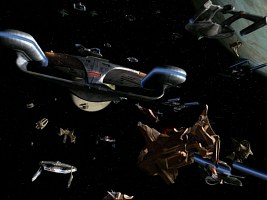
 CGI Federation and Romulan starships in DS9: "Tears of the Prophets"
CGI Federation and Romulan starships in DS9: "Tears of the Prophets"